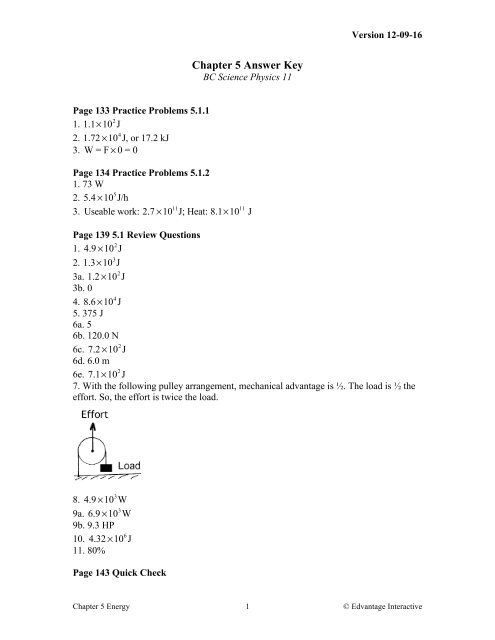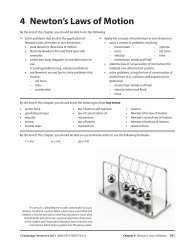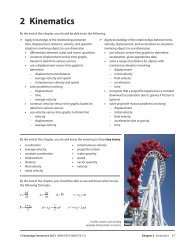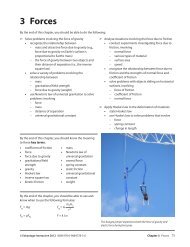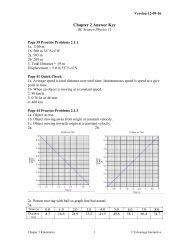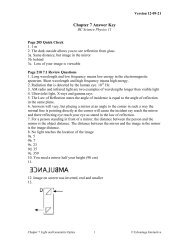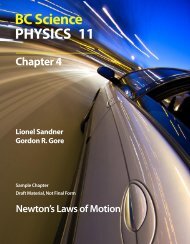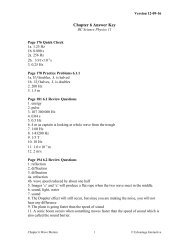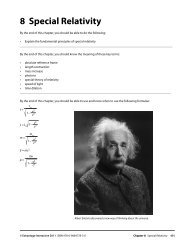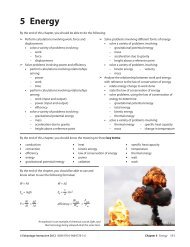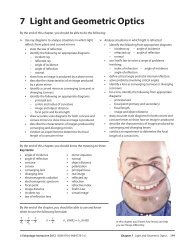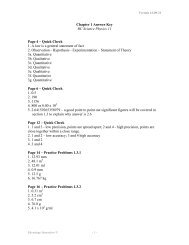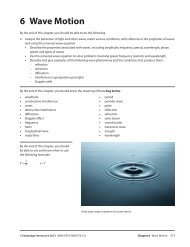Chapter 5 Answer Key - BC Science Physics 11
Chapter 5 Answer Key - BC Science Physics 11
Chapter 5 Answer Key - BC Science Physics 11
You also want an ePaper? Increase the reach of your titles
YUMPU automatically turns print PDFs into web optimized ePapers that Google loves.
Page 133 Practice Problems 5.1.1<br />
1. 1.1×10 2 J<br />
2. 1.72 ×10 4 J, or 17.2 kJ<br />
3. W = F × 0 = 0<br />
<strong>Chapter</strong> 5 <strong>Answer</strong> <strong>Key</strong><br />
<strong>BC</strong> <strong>Science</strong> <strong>Physics</strong> <strong>11</strong><br />
Page 134 Practice Problems 5.1.2<br />
1. 73 W<br />
2. 5.4 ×10 5 J/h<br />
3. Useable work: 2.7 ×10 <strong>11</strong> J; Heat: 8.1×10 <strong>11</strong> J<br />
Page 139 5.1 Review Questions<br />
1. 4.9 ×10 2 J<br />
Version 12-09-16<br />
2. 1.3×10 3 J<br />
3a. 1.2 ×10 2 J<br />
3b. 0<br />
4. 8.6 ×10 4 J<br />
5. 375 J<br />
6a. 5<br />
6b. 120.0 N<br />
6c. 7.2 ×10 2 J<br />
6d. 6.0 m<br />
6e. 7.1×10 2 J<br />
7. With the following pulley arrangement, mechanical advantage is ½. The load is ½ the<br />
effort. So, the effort is twice the load.<br />
8. 4.9 ×10 3 W<br />
9a. 6.9 ×10 3 W<br />
9b. 9.3 HP<br />
10. 4.32 ×10 6 J<br />
<strong>11</strong>. 80%<br />
Page 143 Quick Check<br />
<strong>Chapter</strong> 5 Energy 1 © Edvantage Interactive
Version 12-09-16<br />
1. Doubling mass will double kinetic energy, but doubling speed will quadruple kinetic<br />
energy.<br />
2. 4.19 ×10 4 J<br />
3. 1.8 ×10 5 J<br />
4. 7.2 ×10 −2 J<br />
Page 144 Quick Check<br />
1. Potential energy doubles<br />
2. 25.3 kg<br />
3. 6.12 m<br />
Page 147 Practice Problems 5.2.1<br />
1. 7.67 m/s<br />
2. 31.9 m<br />
3. 5.10 m<br />
Page 148 5.2 Review Questions<br />
1. 3.14 ×10 4 J<br />
2a. 4.4 ×10 5 J<br />
2b. 750 m<br />
3. 1.63 m/s 2<br />
4. 7.41 m/s<br />
5a. 2.0 ×10 2 J<br />
5b. 0.31 m<br />
6a. 20% lost<br />
6b. Heat, sound, friction energy loses account for energy lost<br />
7. 3.8 ×10 3 J<br />
8a. 5.2 J<br />
8b. Force is not constant as spring compresses. Average force identifies the assumption<br />
of constant force is being used.<br />
Page 151 Quick Check<br />
1a. Temperature is the average translational kinetic energy of all molecules in a material.<br />
Thermal energy is the total energy of all molecules in an amount of material. Heat is the<br />
amount of thermal energy transferred between one material to another.<br />
1b. Heat refers to transfer of thermal energy. A body contains thermal energy.<br />
2a. 293 K<br />
2b. 586 K; 313 o C<br />
3a. water<br />
3b. nail<br />
3c. nail loses heat to water<br />
3d. water; neither<br />
Page 154 Quick Check<br />
<strong>Chapter</strong> 5 Energy 2 © Edvantage Interactive
Version 12-09-16<br />
1. convection<br />
2a. breeze toward shore<br />
2b. breeze away from shore<br />
2c. early morning breeze goes out to sea<br />
3. Vacuum stops conduction, convection. Silvered walls reflect radiant heat back into the<br />
bottle. Rubber or plastic stopper slows heat transfer by all three methods.<br />
4. Dirty snow absorbs more radiant heat.<br />
Page 159 5.3 Review Questions<br />
1. translational, rotational and vibrational<br />
2. 303 K<br />
3. radiation<br />
4. from 2 to 1, and from 3 to 4<br />
5. body heat is reflected back to the body. Hypothermia victims require warming from the<br />
outside, and the suit prevents this.<br />
6. radiation<br />
7. convection<br />
8. metal blades conduct thermal energy away faster.<br />
Page 161 Practice Problems 5.4.1<br />
1. 2.3×10 7 J<br />
2. 39 o C<br />
3. 4.0 ×10 6 J<br />
4. Water has a very high specific heat capacity<br />
5. c = 3.9 ×10 2 J/kg/C<br />
Page 163 Practice Problems 5.4.2<br />
1. 90%<br />
2. 960 W<br />
3. 3.0 W<br />
4. 12% efficient<br />
Page 165 5.4 Review Questions<br />
1. 5.0 ×10 4 J<br />
2. 1.5×10 5 J<br />
3. 1.47 ×10 5 J<br />
4. 14.7 MJ<br />
5. 200 J/kg/C<br />
6a. 0.0455 C/s<br />
6b. 95.6 W<br />
6c. 100 W<br />
7. Higher specific heat capacity of water means ocean water helps moderates temperature<br />
8. Three times as much light is emitted by the fluorescent light bulb<br />
9. 90%<br />
<strong>Chapter</strong> 5 Energy 3 © Edvantage Interactive
Page 167 <strong>Chapter</strong> 5 Review Questions<br />
1a. 9.86 J<br />
1b. 0<br />
2. 126 J<br />
3. Same amount of work both ways<br />
4a. 4<br />
4b. 60 N<br />
4c. <strong>11</strong>.2<br />
4d. 4.2 ×10 2 W<br />
5a. 12<br />
5b. 2.40 m<br />
5c. 168 J<br />
5d. 168 J<br />
6. 3.6 ×10 6 J/s<br />
7. 20 kJ<br />
8. 3Ek<br />
9. 17 cm<br />
10. 20 cm<br />
<strong>11</strong>. 9.9 m/s<br />
12. 523 K<br />
13. 323 o C<br />
14. Metal a good conductor of thermal energy<br />
15a. convection<br />
15b. conduction<br />
15c. radiation/conduction<br />
16. convection. Warm water is less dense than cold water<br />
17. Water gives off 10 times as much heat.<br />
18. approximate 36 o C<br />
19. 720 kJ<br />
20. 93%<br />
Page 171 <strong>Chapter</strong> 5 Extra Practice<br />
1.<br />
2a.<br />
2b.<br />
3.<br />
4.<br />
5.<br />
6a.<br />
6b.<br />
6c.<br />
6d.<br />
6e.<br />
7a.<br />
7b.<br />
Version 12-09-16<br />
<strong>Chapter</strong> 5 Energy 4 © Edvantage Interactive
8a.<br />
8b.<br />
9.<br />
10.<br />
<strong>11</strong>.<br />
12.<br />
13.<br />
14a.<br />
14b.<br />
14c.<br />
14d.<br />
14e.<br />
15.<br />
16.<br />
17.<br />
18.<br />
19.<br />
20.<br />
21.<br />
22.<br />
23.<br />
24<br />
Version 12-09-16<br />
<strong>Chapter</strong> 5 Energy 5 © Edvantage Interactive


